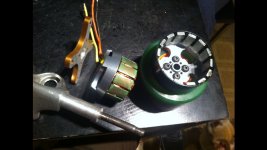Hummina Shadeeba
10 MW
 Continuing. Whether the rotor crashes into the stator with weight or if the bearings die I will find out. The bearings include (8) 5/16 by 1/2 inch and a thrust bearing. At this point I sit trying to true the rotor to the axle. I've gotten it to 1/100 an inch but I think the internal space of a motor is 3 and there's more I can do to get there so I'm not trying it yet. The skate axle isn't perfectly straight either so I'm fixing the stator with epoxy instead of the mounting plate seen here and I'll add a keyway. Since the axle isn't straight I'm going to set the stator's position by using two layers of duct tape between the stator and rotor to hold it in position to where the rotor will spin while it sets.
Continuing. Whether the rotor crashes into the stator with weight or if the bearings die I will find out. The bearings include (8) 5/16 by 1/2 inch and a thrust bearing. At this point I sit trying to true the rotor to the axle. I've gotten it to 1/100 an inch but I think the internal space of a motor is 3 and there's more I can do to get there so I'm not trying it yet. The skate axle isn't perfectly straight either so I'm fixing the stator with epoxy instead of the mounting plate seen here and I'll add a keyway. Since the axle isn't straight I'm going to set the stator's position by using two layers of duct tape between the stator and rotor to hold it in position to where the rotor will spin while it sets. I've found u can reterminate a motor to wye outside the motor, which I've found a lot easier than opening it up and somehow removing the bearing tube. I'll do it later if all else is good. This'll give it more needed torque which is needed since there's no gearing.
But...the one in this pic sits with the bearings stuck on with "retaining fluid". Pretty much glue. My better recent attempt I'm using a tacon 160. Probably harder with its length
The rotor holds it's position on the axle by being bolted to a 2 inch bearing-filled tube that sits in the wheel.





